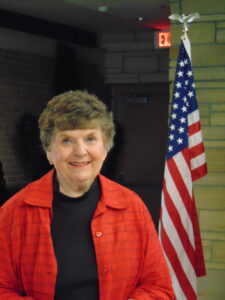The Beauty of Barns kicks off this year’s presentations at BCMH
By Anne Eickstadt

ANNE EICKSTADT PHOTO Belvidere Daily Republican
Carol Rowe visited the Boone County Museum of History to deliver a presentation on The Beauty of Barns – the first of a number of fascinating events held at BCMH this year.
Editor
Carol Rowe visited the Boone County Museum of History on Saturday, March 17, with stunning photographs of farms throughout Boone County and beyond in a celebration of ‘The Beauty of Barns.’
Rowe explored the history of the different types of iconic Midwestern barns. “Family barns have been a vital image on the American scene,” Rowe said. “Symbols of harvest, shelter, honest effort, and hard work, barns are simple, yet powerful structures on our landscape. The barns found throughout Northern Illinois and Southern Wisconsin show us the various ethnic influences and architectural styles of these great buildings of our past.”
Barns were often used for storing crops while animals were housed in a separate structure. Eventually barns became used for both crop storage and animal shelters. The buildings were frequently made of logs. Trees were plentiful and cost the farmer nothing. They could be cut with a simple axe and the famer could, at the same time, clear the land for planting crops.
The type of barn which was erected might identify the heritage of the farmer. Dutch barns had a specific construction type with a broad gable roof. [Gable roofs have a triangular shape to them. Many houses today have gable roofs.] The Dutch would use mortise and tenon construction with pegs to secure the beams. The Germans brought their own style of architecture with them as well and used gambrel roofs which provided more room for storage, instead.
Bank barns were built into the south side of a hill, or ‘banked’ earth, to provide easy access to two levels with crops, hay, and feed on the higher level and animals on the lower level. The animals could enjoy the more protected southern side in the winter as they basked in the sun.
Round barns were promoted as being aerodynamically able to survive tornados and severe storms. But carpenters did not like the curving shape and these round ‘apple’ barns never became the norm. Oval barns were even stronger and cheaper to build, their developer Frank Barnes said. But only a very few were ever constructed.
Prairie barns possess a peak roof above a hayloft opening. It is a familiar image brought to mind when Midwesterners think of barns. These barns housed both hay/feed, and animals and this style may have been brought to the area by German settlers.
Tobacco barns, dairy barns, even medium-small carriage barns also have unique features to…
For complete article, pick up the March 25 Belvidere Daily Republican.


